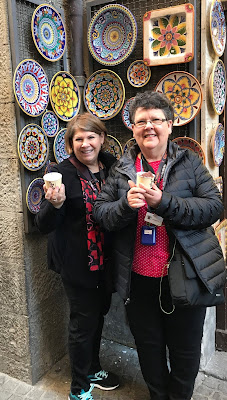I'm using my slice of life writing to recap my trip to Italy in February. Our trip was go-go-go and I neglected to write about it as it happened. This is my attempt to collect my thoughts and pictures in one place.
On
Valentine's Day, it was time to say goodbye to Sorrento. We had an
early departure since we were adding Pompeii to an already busy day. (We
missed our scheduled stop there on Day 4.)
Amazing to think that these streets were built more than 20 centuries ago! Most intersections have crosswalks of raised stepping stones which allowed pedestrians to cross without getting their sandals wet. Three stepping stones signified a major thoroughfare.
You can see the ruts from the chariots which straddled the stones
(all had standard-size axles).
Pics from inside the public baths
I think this is the large theater that could seat 5,000 people.
You can see the well in the center and the
brick oven in the back yard on the right.
Our next stop, several hours down the road, was the town of Orvieto, sitting majestically 1000' above the valley floor
on a chunk of tufa or volcanic stone.
Orvieto's Cathedral or Duomo, a mix of Romanesque & Gothic styles, was constructed in 1290 in order to provide a home for an interesting relic - the Corporal of Bolsena.
Ippolito Scalza was an Orvieto native who carved the Pieta from a single block of marble, 1570-1579. He also designed
the pipe organ in the cathedral.
We enjoyed browsing the streets with stops in shops, bakeries,
and of course our requisite gelato treat.
After leaving Orvieto, we had a two hour drive to Florence and Hotel Mediterraneo, our base for the next three nights.























What a trip! So many amazing sights! Walking on streets built so long ago. The marble carving is most amazing. So beautiful.
ReplyDeleteRamona, your trip sounds wonderful and you captured it as not only a memory for you but a travel log for me. I especially loved the statue of the Pieta, which has been a symbol of love, faith, and hope.Thank you for sharing.
ReplyDeleteI went to Orvieto in the early 80s. I was desperate to go because I'd read an article about it in some travel magazine that really drove home the point that Orvieto was crumbling and didn't have much time left in the world. So I added it to my itinerary ... and loved it. I love even more seeing your pictures and being pleased to see that this pretty city is still (of course) right where I left it, having a laugh at myself and that long-ago travel article! Your trip looks fabulous!
ReplyDeleteCan you imagine? Twenty feet of ash! How wonderful your trip was. I love each part, but maybe especially the views.
ReplyDelete